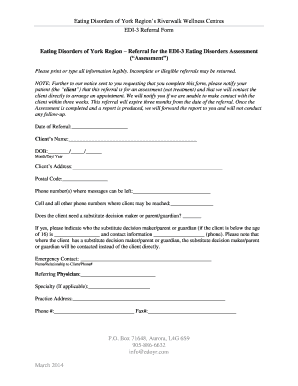Loading

Get Edi-3 Assessment Referral Form - Eating Disorders Of York Region
How it works
-
Open form follow the instructions
-
Easily sign the form with your finger
-
Send filled & signed form or save
How to fill out the EDI-3 Assessment Referral Form - Eating Disorders Of York Region online
This guide provides a comprehensive overview of how to properly complete the EDI-3 Assessment Referral Form for the Eating Disorders of York Region. By following these instructions, you can ensure that all information is accurately provided online, facilitating a smoother referral process.
Follow the steps to fill out the EDI-3 Assessment Referral Form accurately.
- Press the ‘Get Form’ button to access the EDI-3 Assessment Referral Form, which will open in an editable format. Make sure to secure a digital copy of the form before proceeding.
- Begin filling out the form by entering the date of referral in the designated space, ensuring the date is written in the format Month/Day/Year.
- Input the client’s full name clearly and legibly in the designated field to avoid any confusion.
- Provide the client’s date of birth by entering the Month, Day, and Year in the appropriate format.
- Fill in the client’s address, making sure to include the postal code for accurate communication.
- Enter the phone number(s) where messages can be left, including the cell phone number and any other relevant numbers where the client can be reached.
- Indicate whether the client requires a substitute decision maker or a parent/guardian. If yes, provide the name and contact information of the substitute decision maker or guardian.
- Record the emergency contact information, including the name, relationship to the client, and phone number.
- Fill out the referring physician's name and specialty, if applicable, ensuring the practice address is included.
- Indicate the phone number and fax number for the referring physician clearly.
- List the presenting problem(s) that the client is experiencing, including specific behaviors or symptoms.
- Provide the client's height and current BMI in the designated fields.
- Input the current weight, lowest weight, and the respective dates for each weight entry.
- Confirm if the client has been notified about the assessment fee and check the appropriate box.
- Add any general comments that may be relevant to the referral process.
- Upon completion, download and save the changes made to the form. Users can then choose to print or share the form as needed.
Be proactive and complete the EDI-3 Assessment Referral Form online today.
The original questionnaire consisted of 64 questions, divided into eight subscales. It was created in 1984 by David M. Garner and others. There have been two subsequent revisions by Garner: the Eating Disorder Inventory-2 (EDI-2) and the Eating Disorder Inventory-3 (EDI-3).
Industry-leading security and compliance
US Legal Forms protects your data by complying with industry-specific security standards.
-
In businnes since 199725+ years providing professional legal documents.
-
Accredited businessGuarantees that a business meets BBB accreditation standards in the US and Canada.
-
Secured by BraintreeValidated Level 1 PCI DSS compliant payment gateway that accepts most major credit and debit card brands from across the globe.


